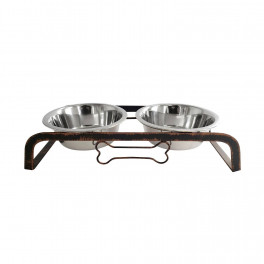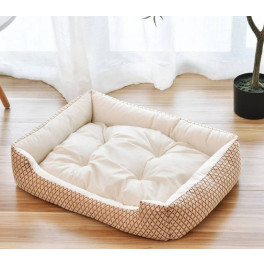As any cat person can tell you, your kitty can be the light of your life, while still driving you crazy. A perfect example of this is the frisky feline who constantly tries to squeeze right past you out the door. Cats are quick and clever, and it can be hard to outsmart and outmaneuver them. Sometimes it’s quite a challenge to figure out how to keep your cat inside the house if Mittens is motivated to make a break for it.
Cat Door Barrier Options
There are several options for cat door barriers. The easiest to install and use is a pet gate to block your cat at the door. A gate goes a long way toward thwarting attempts to dart out when you are entering or exiting your home. Even if Socks comes barreling right to the door as you open it, she will come face to face with the closed pet gate. Getting past you now involves jumping over an extra barrier instead of just slipping past your ankles.
Now, you know your puss better than anybody else does. How motivated and how athletic your cat is will have an impact on the gate that you select. A height of at least 2 feet is necessary to discourage most cats from attempting to jump over. If Whiskers is being particularly unruly, you may just want to hop over yourself without opening the gate, so select height accordingly.
Many, but not all pet barriers have a swinging section that opens, allowing people to walk through. However, some are designed to be set in place and remain there without opening, so be sure to take note of specifics when selecting your gate. A door that swings in both directions is optimal, as it allows you to push the door toward your cat, backing her up, whether you are coming in or going out.
Most cat gates are easily installed using a pressure mounted set up with rubber bumpers. My cat gate, the Carlson Pet Products Design Studio Metal Walk-Thru Gate, took about five minutes to get in place. It was easy to get the proper tension with the simple screw in bumper system, and the door is very secure. The bumpers are also very easy on the door frame, and don’t cause any damage.
Many pet gates that lack doors also use a pressure mounted installation system, but they cannot be opened and closed without removing the unit entirely. Again, look carefully at the options and be sure of your needs before you buy. Although pet gates with walk through doors tend to be a little more expensive, it’s worth the money if you don’t want to have to step over your gate every time you come in or go out.
In some cases, hardware may be involved in installation, making the gate more permanent. That could be a good thing if you love it, or a bad thing if it doesn’t work out the way you had planned. Also check measurements—if you have a storm or screen door, it may be a tight fit to get the pet gate between that and the solid door. You also want to make sure the gate is wide enough for the opening of the doorframe. Some models offer extra panels if you need an extension.
Don’t forget to consider appearance as you decide which pet gate to buy. There are plenty of options available, in various materials and finishes. It shouldn’t be difficult to find something that fits in with your home décor. From country white to zebra panels, the perfect pet gate for you is out there. You can shop in store or online at pet supply chains like PetSmart and PetCo, or with strictly online vendors such as Drs. Foster & Smith, or Chewy.com.
Cat barriers for slider doorways can be a little trickier. Sliders will not serve as a partial block the way that a conventional door does, so stepping through a swinging door in a pet gate will still leave a wide slip through area. My little man, Nelson, is a runner, and always makes a break for the sliding door onto the deck. Even his older, lazier sister, Alice, is tempted by the deck door.
Well, it turns out that one of those simpler, door free pet gates designed to be put up and left up works perfectly for my sliders. The narrow profile fits right into the space between the door track and the screen track. I set the tension bar nice and snug, and locked the handle in place. My husband and I don’t use the deck nearly as much as the front door, so stepping over the gate isn’t an issue.
I chose a heavy plastic gate because it does have some outdoor exposure, unlike the front door gate, which is protected by a storm door and a covered porch. It isn’t a beautiful barrier, but it does the job, and after all, we can always close the blinds.
Measure Twice
A word of caution: Make sure to measure the space between your door tracks carefully before purchasing a gate for sliders. There is a lot of variation in the size of this space from one home to another. In some cases, a pet gate may not fit, so save yourself the trouble of a possible return by checking measurements before you buy.
If your sliders are not constructed with a wide enough space to fit a barrier, a free standing pet gate or folding pen is another possible solution. With multiple configurable panels, you can set up a small “holding area” on either side of the door to contain frisky felines, using the step through gate yourself. Just make sure that the gate is tall enough to deter jumping over, and weighted at the bottom to prevent pushing over. Remember, it only has to hold Snowball back long enough for you to enter or exit.
Now, what about a cat barrier that is strictly indoors? Say you want to keep Dr. Claw out of the bedroom, or in my case, out of the kitchen when we have our bird out for some love. Well, there’s always closing the door of the room you want kitty to stay out of… if there is a door. If your home has a more open floor plan, you may not have or want a permanent door.
A pet gate is not much of a deterrent to a cat if it is set up in a door frame without a closed door on at least one side. If there is easy, visible clearance on both sides of a barrier less than 3 feet high, most felines will be able to jump over it. Three feet is not even much of a problem for my gymnastic duo, so neither of my pet gates would be any good in the door free kitchen.
My solution? A sturdy portable room divider. Two to four panels of heavy wood or composite material will keep your devious feline out of the forbidden zone, and out of trouble. Mine is from Pier 1 Imports, but I got it through Letgo for $20. It stands about 5 feet 8 inches tall, and it’s heavy enough to prevent pushovers when in position blocking the entry to the kitchen. It has a low storage profile because it folds flat, so it can easily be kept in a closet, or behind a bookcase.
Cat Gate Alternatives
If barriers don’t completely eliminate the mad dash for the door, there are a few other things you can try. Be sure you don’t reinforce Bandit’s bad behavior with positive attention after he tries to get out. He shouldn’t associate rushing the door with being cuddled afterwards. Keep positive interactions like petting, snuggling and treats away from door areas. Keeping your kitty busy may lessen his interest in getting outside, so be sure to provide plenty of toys and scratching post options to keep him engaged (catnip can’t hurt, either!)
As you work on finding the best way to keep your feline children and safe and (fairly) well behaved in your home, consider microchipping your babies as a backup. If your indoor cat wants to go out all the time, there’s a chance she will make it at some point, despite your best efforts. For less than $50.00, you can give yourself the peace of mind that your little spitfire can be permanently identified, even if she slips her collar. In the meantime, grab your tape measure and head for the nearest door—AFTER you lock Sneaky Pie in the bathroom!
























